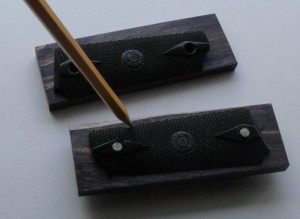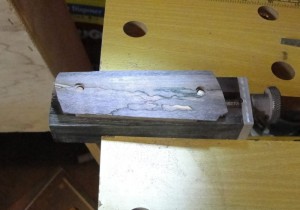OK, switch over to the right side of your brain for part two: making the scales pretty. I’m using an acrylic impregnated stabilized wood which has several good features:
It won’t absorb oils or cleaning chemicals, prevents warpage or shrinkage and you won’t wear the finish off.

Use your jig or original grip to make sure the holes all lined up perfect, you can even try putting them in place on the pistol to be sure. No sense in working the wood if they aren’t even going to fit.
Trace the profile of the grip from the original onto the scale.

Using a sanding block and 80-grit sandpaper, sand the edges to your pencil marks and test fit on the pistol to make sure the edges line up where you want them and correct as necessary. Use a little round file or paper wrapped around a pen for the corner reliefs.
Test fit on the pistol once you get the profile right.

Now get your sanding block or belt/disc sander if you have one, and start sanding the curve of the grips with some 80 grit. The peak needs to be 1/4″ thick. To hold the scale in place while sanding, use some strong double-sided outdoor tape to hold it to a piece of wood. I use a little tool made just for holding grips. Compare it to the original as you work to make sure you get the bottom bevel right, and TAKE YOUR TIME.

Make one final test fit to make sure you shaped everything just right.

Next, make some 1″ strips of 120, 220, 400, 600, 800, 1000and 1200 grit sandpaper and sand the scale in increasing grits shoe-shine style. Take your time, spend a good 5-10 minutes per grit to really get the scratches out from the previous grit. At the end you can use a buffing wheel or a dremel with a felt wheel and red buffing compound to really get it smooth.




After all that sanding and polishing you can get it pretty smooth. This has NO oil or anything and it looks great. The tiger stripes are pearlescent and change light to dark depending on your view angle.

You can put a little tung or tru-oil on there bit remember: This is acrylic preserved wood, it won’t soak up anything! It might help shine up the microscopic buffing compound or the 1200 grit ‘scratches’ but I put some on there and couldn’t tell any difference. I think they look great as-is!


2 Responses to How to make 1911 .45 pistol grips, part 2